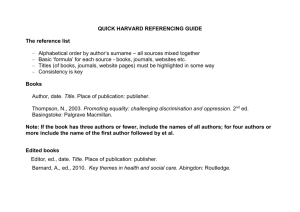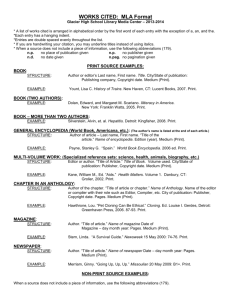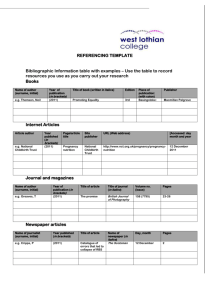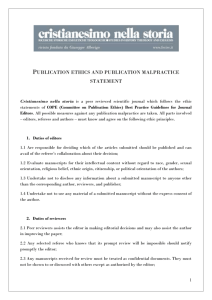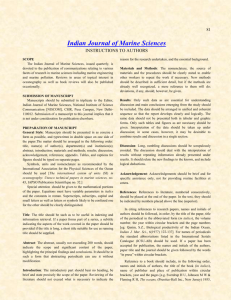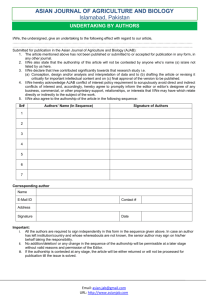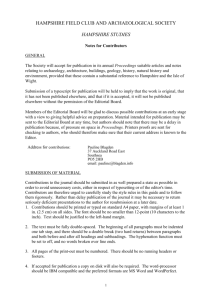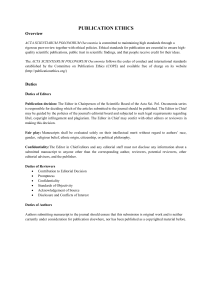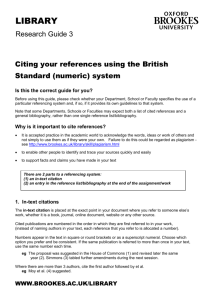Guidance Notes for contributors
advertisement
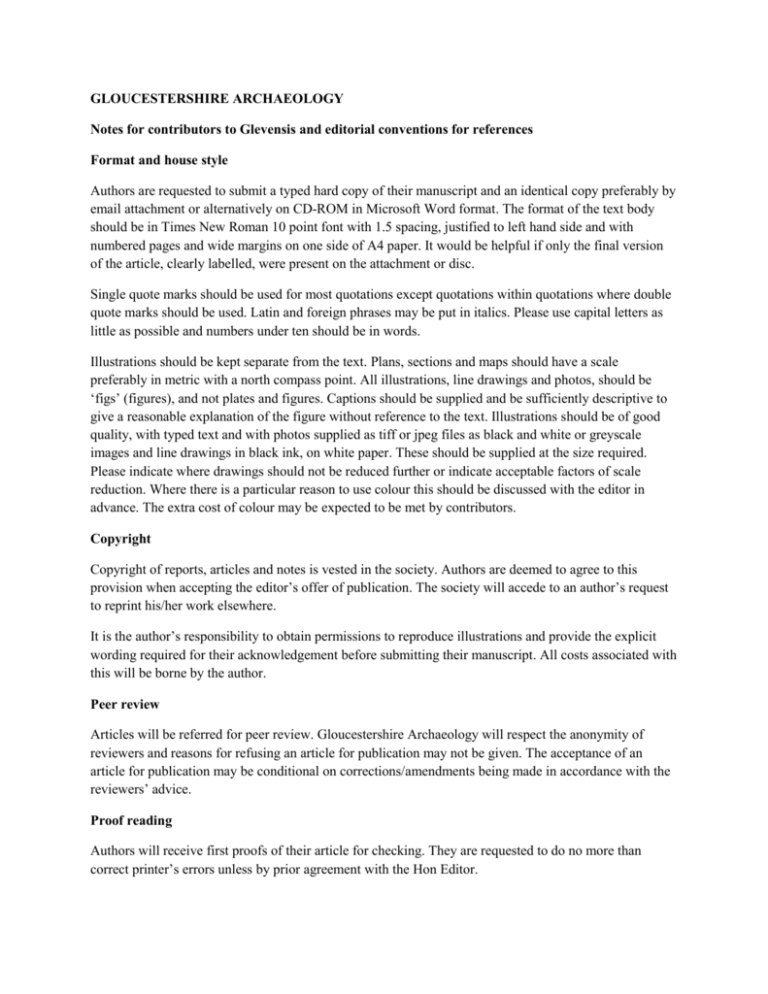
GLOUCESTERSHIRE ARCHAEOLOGY Notes for contributors to Glevensis and editorial conventions for references Format and house style Authors are requested to submit a typed hard copy of their manuscript and an identical copy preferably by email attachment or alternatively on CD-ROM in Microsoft Word format. The format of the text body should be in Times New Roman 10 point font with 1.5 spacing, justified to left hand side and with numbered pages and wide margins on one side of A4 paper. It would be helpful if only the final version of the article, clearly labelled, were present on the attachment or disc. Single quote marks should be used for most quotations except quotations within quotations where double quote marks should be used. Latin and foreign phrases may be put in italics. Please use capital letters as little as possible and numbers under ten should be in words. Illustrations should be kept separate from the text. Plans, sections and maps should have a scale preferably in metric with a north compass point. All illustrations, line drawings and photos, should be ‘figs’ (figures), and not plates and figures. Captions should be supplied and be sufficiently descriptive to give a reasonable explanation of the figure without reference to the text. Illustrations should be of good quality, with typed text and with photos supplied as tiff or jpeg files as black and white or greyscale images and line drawings in black ink, on white paper. These should be supplied at the size required. Please indicate where drawings should not be reduced further or indicate acceptable factors of scale reduction. Where there is a particular reason to use colour this should be discussed with the editor in advance. The extra cost of colour may be expected to be met by contributors. Copyright Copyright of reports, articles and notes is vested in the society. Authors are deemed to agree to this provision when accepting the editor’s offer of publication. The society will accede to an author’s request to reprint his/her work elsewhere. It is the author’s responsibility to obtain permissions to reproduce illustrations and provide the explicit wording required for their acknowledgement before submitting their manuscript. All costs associated with this will be borne by the author. Peer review Articles will be referred for peer review. Gloucestershire Archaeology will respect the anonymity of reviewers and reasons for refusing an article for publication may not be given. The acceptance of an article for publication may be conditional on corrections/amendments being made in accordance with the reviewers’ advice. Proof reading Authors will receive first proofs of their article for checking. They are requested to do no more than correct printer’s errors unless by prior agreement with the Hon Editor. Referencing The reader should be able to check and follow up the evidence for statements made by the author, by means of a referencing system. This also protects the author against charges of plagiarism. Glevensis uses both the Harvard system for archaeological reports and the ‘running note’ method of citation, for historical articles. Notes and references will be printed at the end of the text and should be supplied typed in sequence. If notes are necessary for an archaeological report, these should be placed in a separate section before the references and numbered sequentially here and in the text. Harvard method: 1. Published works should be listed in the references as follows: Alford, D. P., The Abbots of Tavistock (Plymouth: Brendon and Sons, 1891). A second or further edition should be noted before the bracket. 2. For journal articles: Smuts, R. M., ‘The Puritan Followers of Henrietta Maria in the 1630s’ in English Historical Review, 92, 26-45. 3. In the body of the text the, authors and date of publication should appear in brackets after the relevant piece of text e.g. (Smith, 1998, 23-35), if more than one reference paper was published in one year use of a, b, c, to distinguish in both text and references may be used e.g. Smith 1999a. Multiple authors can be referenced in the text as Smith and Smith 1997, or Smith et al 1997. Initials will be given in the references. 4. Repeat references, maps and web references are as under sequential referencing. Sequential method: 1. Each cited reference has a separate sequential number, superscripted in the text in 7 point Times New Roman font after the punctuation mark. 2. Some items in the references may be explanatory notes, but the majority will refer to the source and published sources should be presented as follows: a) For books: Author, editor (with initials) or organisation name. Title of Book (in italics), edition if not first. Place and name of publisher, year of publication (in brackets), page numbers referred to. Example Hoskins, W. G. Fieldwork in Local History, 2nd ed. (London: Faber and Faber, 1982) 41-46. b) For journals: Author’s name. ‘Title of article’ (in quotes), Title of Journal (in italics) volume number (in bold), date (in brackets), page number(s). Example Lloyd, C. ‘Arthur’s Britain’, Landscape History 21 (1999), 9. c) In the case of chapters from edited books or papers from an edited collection, the name of the chapter’s or paper’s author is followed by the 'title' of the article, (in quotes), followed by ‘in’, the name or names of the editor(s) and the title of the book, (in italics), then the publisher, date and page no. as in a) or b) above. Examples: Herbert, N. M., ‘Trade and industry’, in Herbert, N. M., (ed.), VCH Gloucestershire, 4 (1988), 23-24. (This is the standard way of citing the Victoria County History). Moore, D., ‘The charter evidence’ in Aston M. and Lewis C., (eds) The Medieval Landscape of Wessex, Oxbow Monograph, 46 (1994), 97-114. d) Where a reference is to an already referenced book or article, it is sufficient to give the author’s name, a shortened title, and relevant page numbers. But where another reference to the same source immediately follows it, ‘ibid’ may be used, plus the relevant page numbers. Example(s): Hoskins, Fieldwork in Local History, 41-46. Loyd, ‘Arthur’s Britain’, 9. Herbert, ‘Trade and industry’, 23-24 Moore, ‘Charter evidence’, 97-98 e) Maps used should also be referenced. Creator, editor or organisation. Title of map. Sheet number, edition or series title. Place and name of publisher (if given). Examples Map references: Ordnance Survey. 1972. OS map. Plan SO7622-7722 Scale 1:2500 (25”). Ordnance Survey 1885 1st edition OS map. Sheet no 24/8. Scale 25”. f) Web reference: Author or editor, initials. Online title (in italics). Edition (if known). Place and name of publisher (if given) (in brackets). Date of publication. URL (Date accessed) (in brackets). Example Genuki. Gloucestershire town and parish map: Forest of Dean area. http://www.genuki.org.uk/big/eng/GLS/GLSImgMap1.html (Accessed 26.11.06). 3.Unpublished documentary sources should be referenced by the location of the document, its local reference number and the folio number(s). The document’s description and date is also desirable. Examples (explain any abbreviations used in text): NA. National Archives, STAC/7/16/5 ff.1-10 (1601 depositions). GA. Gloucester Archives, D3398 1/7/10. Deeds of lease and sale 1851-1880. 4.Information provided by individuals should be referenced by: Name of source: Personal communication. Date information given. Acknowledgements These can be given under a separate heading at the end of the paper, before the notes and references. Deadline for submissions October 31st. The Editor will subsequently notify you whether your paper has been accepted and discuss any changes needed. Amended and updated by Diane Charlesworth, Les Comtesse and Russell Weston, January 2015. from guidance by Nigel Spry and Don Mayes (n.d.) and Martin Ecclestone 2004.
